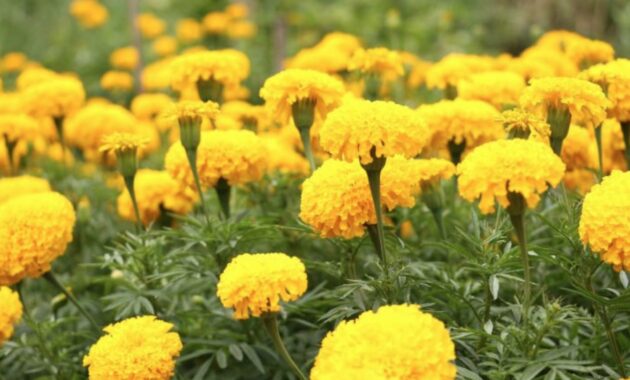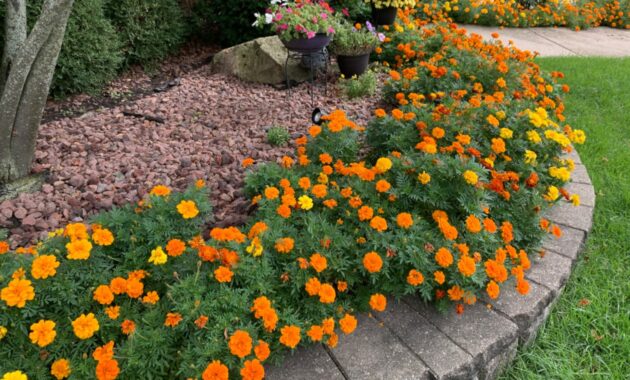
Marigolds! Who doesn’t love these bright, cheerful flowers? I remember planting my first marigolds when I was just starting out with gardening. They were the only flowers I could grow without completely messing things up, and since then, they’ve become a staple in my garden. But marigolds are more than just a pretty face—they have tons of benefits that go beyond their vibrant blooms.
In this post, I’ll share everything I’ve learned from growing marigolds: how to care for them, their surprising uses, and why they should be an essential part of any garden, whether you’re a newbie or a seasoned pro.
What is the Marigold Plant?
Marigolds (Tagetes species) are bright, sunny flowers that are part of the Asteraceae family, commonly known as the daisy family. They are super popular in gardens around the world for their brilliant colors and their ability to repel pests. From golden yellows to fiery oranges, marigolds are like little suns that brighten up any garden space.
| Feature | Description |
|---|---|
| Scientific Name | Tagetes |
| Common Names | Marigold, African Marigold, French Marigold |
| Native Region | Central and South America |
| Plant Type | Annual and perennial herbs |
| Height | 15 cm to 90 cm (6 inches to 3 feet) |
| Uses | Ornamental, companion planting, medicinal, culinary |
| Blooming Time | Late spring to autumn |
The Different Types of Marigolds
I didn’t realize there were so many types of marigolds until I started experimenting in my garden. Some are compact and perfect for containers, while others can get quite tall and make fantastic border plants. Here are the main types of marigolds you might encounter:
| Type | Description |
|---|---|
| French Marigold (Tagetes patula) | Compact and bushy, growing up to 30 cm tall. These are great for flower beds or containers. They come in vibrant shades of yellow, orange, and red. |
| African Marigold (Tagetes erecta) | Larger and more robust, reaching up to 90 cm. These are excellent for border plants and can fill out a garden bed quickly. |
| Signet Marigold (Tagetes tenuifolia) | More delicate flowers with lacy foliage. These have a citrus-like scent and are often used in culinary dishes. |
| Triploid Marigold | A hybrid between French and African marigolds, known for their large, vigorous blooms and high tolerance to heat. |
Each type has its charm, but my personal favorite is the French Marigold. They are smaller, sure, but they pack a punch when it comes to color and pest control.
Why Every Gardener Should Plant Marigolds
Okay, let’s talk about why you need marigolds in your garden. I’ll be honest—they were my “go-to” plant when I had no idea what I was doing. But as I got more experienced, I realized just how beneficial they are beyond their bright colors.
1. Natural Pest Repellent
I cannot emphasize enough how good marigolds are at keeping pests away. Nematodes, which are tiny, root-destroying worms, hate marigolds. If you’ve had issues with your vegetable garden, planting marigolds around your veggies can act as a natural barrier. I planted marigolds next to my tomatoes one year, and I swear, the tomato plants were healthier than ever.
Not only that, marigolds repel aphids, mosquitoes, and even rabbits. It’s like having a natural pest control service that also looks stunning.
2. Easy to Grow and Maintain
If you’re new to gardening, marigolds are perfect for you. They’re hardy, drought-tolerant, and they thrive in almost any soil. Just plant them in a sunny spot, and they’ll do the rest. In my experience, they don’t need a lot of pampering or frequent watering.
Once, I accidentally left my marigold bed unattended for weeks during a busy period, and guess what? They were still going strong!
3. Attract Pollinators
Marigolds are like magnets for bees, butterflies, and other pollinators. Adding these to your garden will encourage biodiversity and boost the health of your plants. I’ve noticed more butterflies in my yard ever since I started planting marigolds regularly.
Growing Marigolds: My Personal Tips
After several years of growing marigolds, I’ve picked up a few tricks that make the process easier and more successful.
1. Planting Marigolds
I usually start my marigold plants from seeds, which is cheaper and more rewarding (there’s something magical about watching a seed grow into a full-fledged plant). Start your seeds indoors about 6-8 weeks before the last frost, and then transplant them outside once the weather warms up.
If you’re in a hurry, you can always buy young marigold plants at a nursery and plant them directly into your garden.
2. Watering and Sunlight
Marigolds love the sun, so be sure to plant them in a full-sun location. Water them regularly, especially during the first few weeks after planting. However, don’t overdo it—marigolds are pretty drought-tolerant once established, and too much water can lead to root rot.
3. Deadheading for More Blooms
This was a game-changer for me. If you remove the spent blooms (a process called deadheading), it encourages the plant to produce more flowers. I make it a habit to check my marigolds every week and snip off any dead blooms. Trust me, your plants will thank you with more and more flowers.
4. Companion Planting
Marigolds make excellent companions for crops like tomatoes, peppers, and beans. Their pest-repelling properties protect your crops from common garden pests like aphids and whiteflies. I also plant them near my cucumbers and squash—it’s like they create a natural shield!

Health Benefits and Surprising Uses
Marigolds aren’t just eye candy in the garden; they also have some cool medicinal uses and other benefits.
1. Anti-inflammatory Properties
The petals of marigolds have been used in herbal remedies for their anti-inflammatory and antiseptic properties. They can be used to treat minor wounds, burns, and even bug bites. I’ve tried making my own marigold salve, and it worked wonders on a pesky mosquito bite that wouldn’t stop itching!
2. Marigold Tea
Yes, you read that right—you can make tea from marigolds! Marigold tea is known for its ability to reduce inflammation and improve digestion. Just steep some dried marigold petals in hot water for about 10 minutes, strain, and enjoy.
3. Edible Flowers
Marigold petals are edible and can be used to brighten up salads or desserts. I’ll admit, the first time I tried sprinkling them on a salad, I was skeptical, but they actually have a light, citrusy flavor that pairs well with fresh greens.
Fun Fact: Marigolds in Cultural Traditions
In addition to their practical uses, marigolds are highly regarded in various cultures. In Mexico, marigolds (known as cempasúchil) are a significant part of the Día de los Muertos (Day of the Dead) celebrations. Their bright orange and yellow petals are used to create beautiful altars, believed to guide the spirits of the deceased back to their loved ones.
In India, marigolds are often used in Hindu rituals and festivals, where the flowers are strung into garlands and offered to deities. They symbolize purity and prosperity, making them essential during celebrations like Diwali.
My Biggest Marigold Mistake (and How to Avoid It)
Let me share a little story about a mistake I made with marigolds early on. I planted them too close together in my vegetable garden, thinking they’d all grow nicely in a little cluster. Big mistake. As the marigolds grew, they started competing for space, and my vegetable plants didn’t get enough light or air circulation.
I quickly learned to give them plenty of space—planting them about 12-18 inches apart worked best for me. This way, they can spread out without crowding your other plants.
Conclusion: The Must-Have Plant for Every Garden
Whether you’re looking for an easy-to-grow flower, a natural pest repellent, or a plant with medicinal properties, marigolds have you covered. They’ve become a non-negotiable part of my garden for all the right reasons. Plus, they’re just so darn pretty!
So if you’re starting a new garden or just want to add a pop of color to your existing one, don’t overlook the humble marigold. It’s the perfect blend of



